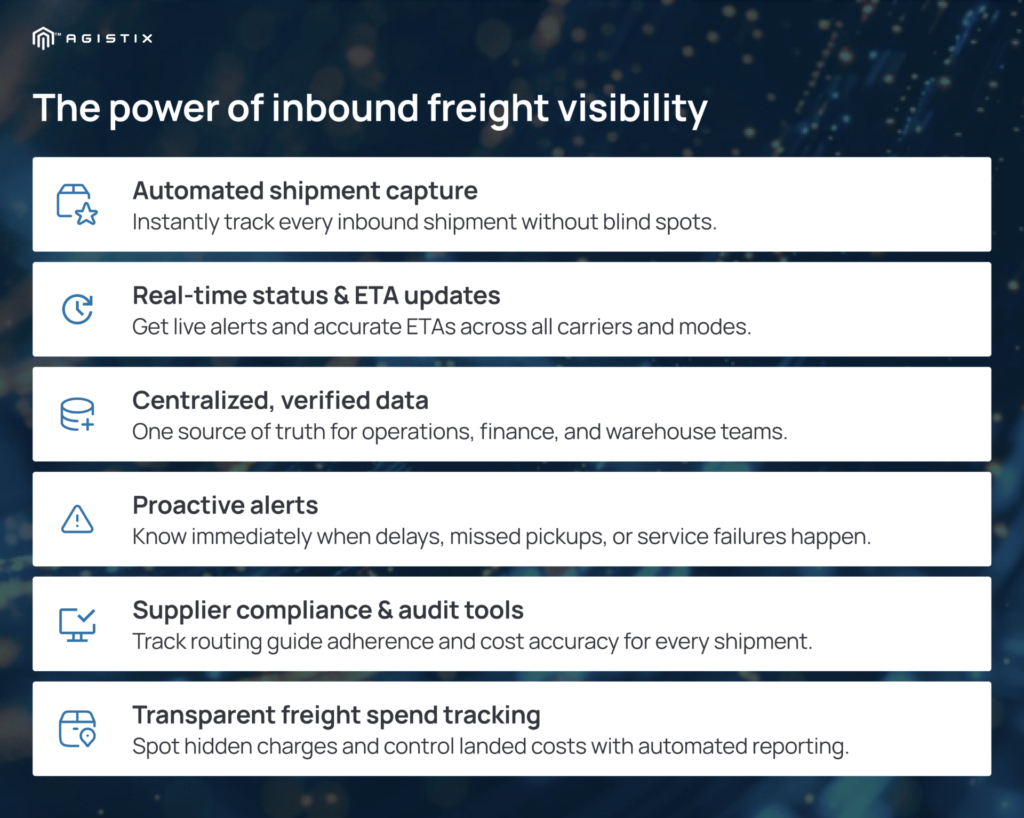June 26, 2025 - 6 minutes read

Inbound Freight Management: Fixing the Visibility Gap
Inbound freight is one of the most crucial yet often overlooked aspects of the supply chain. While most companies have systems in place to track outbound orders—those that are headed to distribution centers, stores, or end-customers—inbound shipments often slip through the cracks. That’s because the majority of inbound freight is booked by suppliers, outside of internal transportation management systems. As a result, there’s no automated data capture to keep companies up-to-date on inbound shipment statuses, ETAs, and potential delays.
That lack of visibility puts the burden on logistics teams, who end up pulling updates from emails, carrier portals, and phone calls—wasting valuable time and resources. To solve it, companies need a way to track inbound freight with the same clarity and control they expect from their outbound network.
What Is Inbound Freight Management?
Inbound freight management is the coordination of goods arriving from external parties, like suppliers or contract manufacturers. It involves scheduling, tracking, and managing incoming shipments to ensure alignment with production timelines, inventory needs, and facility capacity.
While it may seem like a strictly tactical function, analysis by McKinsey & Company shows that inbound freight accounts for 8–12% of total raw material costs. Without visibility into inbound shipments, it’s difficult to control those costs or anticipate issues that can disrupt downstream operations. Delays in inbound shipments can stall production, impact outbound order fulfillment, and strain customer relationships. That’s why inbound visibility is a critical component of any well-run supply chain.
Delays or disruptions can hinder production schedules and impact outbound performance, having massive repercussions on customer relationships. That’s why inbound visibility capabilities are absolutely critical to effective supply chain operations.
Visibility into inbound freight supports:
- Vendor compliance – Confirming whether suppliers are following routing guides, using approved carriers, and meeting service-level expectations.
- Inventory control – Anticipating inbound shipments accurately to reduce safety stock, avoid overordering, and prevent stockouts.
- Production and fulfillment schedules – Keeping manufacturing and order fulfillment on track by avoiding surprise delays in inbound materials.
- Supplier performance – Tracking metrics like fulfillment accuracy, timeliness, and responsiveness to strengthen supplier accountability.
- Freight cost oversight – Understanding how inbound shipments are routed and billed to better control landed supply chain costs.
Without the right tools in place, achieving this level of visibility remains out of reach for most organizations.
Why Inbound Freight Tracking Is Still So Hard
There’s no shortage of visibility platforms on the market. But most are designed to track shipments that are created within their own system, which leaves a massive gap when it comes to inbound freight. Supplier-booked shipments and third-party freight usually fall outside these systems entirely.
To work around this issue, those platforms typically offer a manual entry function that allows users to input details for shipments not created in-system. But that process is time-consuming, inconsistent, and not built to scale. Relying on teams to manually enter shipment data just to create a centralized view defeats the purpose of automation and leads to fragmented, unreliable information.
A true inbound freight management solution should eliminate these blind spots. This means automating the capture of all inbound shipments—regardless of origin—and creating a shared, reliable view for internal teams and external partners alike.
The Cost of Poor Inbound Shipment Visibility
The operational impact of limited inbound visibility is immediate and noticeable. Without accurate, real-time data on what’s arriving, when, and how it was booked, teams are left to make reactive decisions that affect cost, efficiency, and service. These breakdowns show up across the business in numerous ways.
- Production delays – Late or unaccounted-for shipments can stall manufacturing schedules, delay customer orders, and put undue stress on logistics and warehouse teams. These disruptions often create a domino effect that’s felt well beyond the dock.
- Inventory bloat – When teams can’t rely on inbound timing, they often hedge by overstocking. Holding excess inventory might prevent a stockout, but it also increases storage costs and ties up working capital.
- Compliance issues – Routing guides and service-level agreements lose value when there’s no way to verify whether suppliers followed instructions or used preferred carriers. Over time, this erodes consistency and leads to inflated costs.
- Uncontrolled freight costs – When suppliers select carriers or service levels independently, companies often absorb unnecessary costs without realizing it until long after the fact.

Inbound visibility gives companies the control needed to stay ahead of these issues before they drain resources or disrupt operations.
What to Look for in Inbound Tracking Systems
Many platforms claim to offer inbound visibility, but not all of them are built to handle the complexity of supplier-controlled freight. A system that simply consolidates outbound data or requires users to manually input third-party shipments won’t solve the core challenges outlined above. To be effective, inbound tracking solutions need to support the way inbound freight actually moves—across systems, across partners, and often outside the company’s direct control.
Must-Have Features
- Automated capture of all inbound shipment data: Systems should be able to detect and ingest shipment details regardless of booking origin, eliminating the need for manual entry.
- Real-time updates across modes and carriers: Visibility tools should pull status data across truckload, LTL, parcel, ocean, and air to maintain accurate ETAs and delivery expectations.
- Exception alerts without extra portals: Alerts should be pushed automatically when delays, missed pickups, or service failures occur, without requiring users to log in to multiple carrier sites.
- Tools for auditing supplier compliance and freight costs: The system should surface whether suppliers followed routing instructions, selected the correct service level, and booked at acceptable rates.
- Centralized dashboards for ops, finance, and warehouse teams: Visibility should extend across functions so that everyone is working from the same data set, without relying on siloed tools or spreadsheets.
A reliable inbound tracking system should close the gaps so inbound freight stops being a blind spot and starts becoming a source of control.
How Agistix Helps You Manage Inbound Freight Smarter
Agistix was built to solve the challenges most visibility platforms ignore—starting with inbound freight. Unlike systems that rely on manual entry or require all shipments to be booked through their own platform, Agistix Visibility automatically captures shipment data across your entire network, including supplier-booked and third-party freight.
That means no need to overhaul your existing TMS or force suppliers into new processes. Agistix sits on top of your current systems and infrastructure to deliver full visibility into inbound activity, regardless of who booked the freight or which carrier is moving it.
With real-time tracking and automated exception alerts, teams can respond faster to disruptions and avoid costly delays. The platform also surfaces critical insights into supplier routing compliance and inbound freight costs, so you’re actively preventing issues, instead of responding after the fact. And with Agistix Microsites, all stakeholders—including suppliers, carriers, and internal teams—can access real-time shipment data through a shared, secure interface.
Ready to eliminate blind spots in your inbound freight? Request a demo and see how Agistix can give your team the control and clarity they’ve been missing.
